
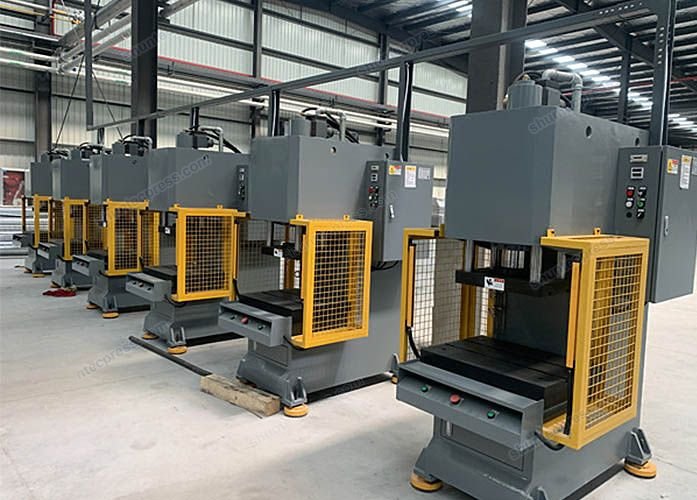
Definition
Hydroforming method refers to the use of liquid water, oil, or viscous material in replacement of a rigid concave mold or convex mold as the force transmission medium so that the material is shaped by fitting the convex mold or concave mold under the pressure of the force transmission medium. It is a kind of flexible forming technology.
Types Of Hydroforming
According To Different Liquid Media Used, Hydroforming Is Divided Into Pressurized-Water Forming And Pressurized-Oil Forming.
The medium used in pressurized-water forming is pure water or an emulsified liquid composed of water and a certain proportion of emulsified oil; the medium used in pressurized-oil forming is hydraulic transmission oil or engine oil.
According To Different Blanks Used, Hydroforming Is Divided Into Three Types: Tube Hydroforming, Sheet Hydroforming, And Shell Hydroforming.
Sheet and shell hydroforming uses lower forming pressure, whereas pipe hydroforming uses higher pressure, also known as internal high-pressure forming. The medium mostly used in sheet hydroforming is hydraulic oil, and the maximum forming pressure generally does not exceed 100MPa. The medium used in shell hydroforming is pure water, and the maximum forming pressure generally does not exceed 50MPa. The medium mostly used in pipe hydroforming/internal high-pressure forming is emulsified liquid, and the maximum forming pressure used in industrial production generally does not exceed 400MPa.
The Main Characteristics Of Modern Hydroforming Technology Which Began To Develop In The Mid-1980s Are Manifested In Two Aspects.
Firstly, since the liquid medium can be used as a convex mold or a concave mold, only a concave mold or a convex mold is needed respectively, so the mold costs and processing time can be saved by 50%. What’s more, the liquid used as a convex mold can form many complex parts that cannot be formed by a rigid convex mold. Secondly, liquid as a force transmission medium has real-time controllability, the pressure can be accurately controlled according to the given curve through the hydraulic closed-loop servo system and the computer control system, which ensures that the process parameters are within the set values, and are variable and adjustable over time, which greatly improves the process flexibility.
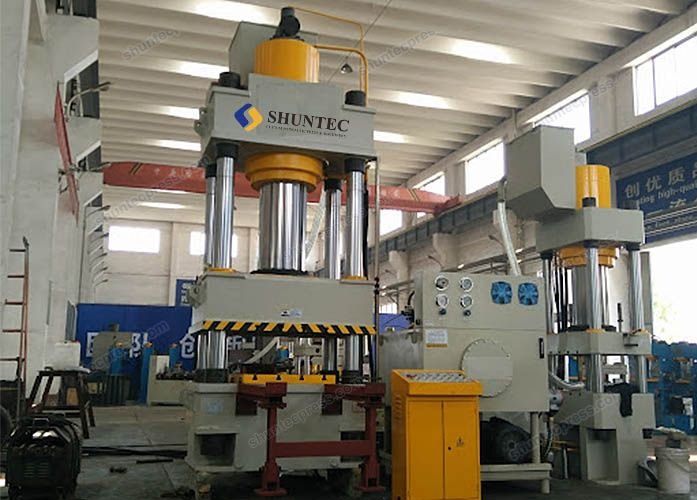

In order to make sure that you purchase the right 300-ton four-column hydraulic press which can reach your expectation of performance and effectiveness and which can be brought into full play in your routine manufacture, you should fully consider the following matters before you make your purchasing decision.
1. Understand The Characteristics Of Different Four-Column Hydraulic Press Manufacturers
At present, there are more and more manufacturers who can offer 300-ton four-column hydraulic presses. In order to exploit the machine’s advantages to the full in the production and processing industry, and make your specific needs satisfied, it is necessary that you understand the characteristics of different brands and confirm whether their prices are reasonable.
The four-column hydraulic press is a kind of equipment that uses an oil pump to transport hydraulic oil for processing operations. It is applicable to the processing of metals, plastics, and rubber, etc., and the effect is fairly good. Some of the advantages of a four-column hydraulic press are as follows:
First of all, it saves costs on mold use. Since a complete set of molds can satisfy the need for processing, costs on mold use can be reduced to a minimum.
Secondly, it can reduce the need for subsequent processing. Nowadays hydraulic presses have been developed to such a high level that they can not only fulfill their own routine duty but further complete the processing of the material as well. Therefore, manufacturers can be saved part of the subsequent processing and reduce production costs.
A four-column hydraulic press has a very stable performance. In actual application, it can reach high working efficiency and production accuracy.
2. Determine Your Specific Product Requirements And Processing Technology
Since the four-column hydraulic press has many specifications and models, before you choose your manufacturer and model, you should determine your specific needs of product function. Consider your own application environment so that the machine you choose can serve your purpose to the best. Choose the right model according to your requirement of production technology, so that the production can be more professional.
Shuntec is a custom 4-column hydraulic press machine manufacturer for years. We build every 4-column hydraulic press directly to your specifications and your unique application. Feel free to contact us when comes to a 4-column hydraulic press.
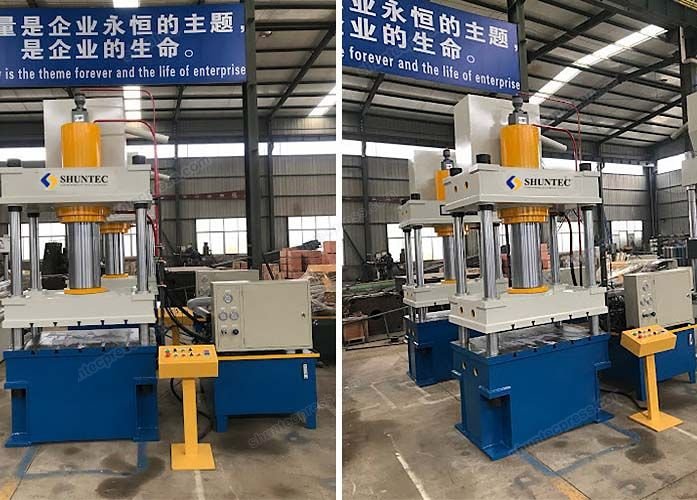

Use Purpose
Shuntec 200 ton four-column hydraulic press is a common machine model used in many industries. Usage includes forging, stamping, cold extrusion, straightening, die-cutting, aluminum sheet stretching, aluminum product die forming, and stainless steel product dies forming.
Structure
Shuntec 200-ton four-column hydraulic press is composed of an upper beam, a sliding block, a worktable, a four-post rod, the main cylinder, a hydraulic power system, and an electrical system. The upper beam, sliding block, and worktable are welded with high-quality steel plates, and the internal stress is eliminated by vibratory stress relief. The surfaces of all four columns are medium-frequency quenched and chrome-plated.
Features
1. Three-stage speed control of the movable beam: fast approaching speed, slow pressing speed, and fast return speed.
2, The main cylinder and the press cylinder have upper and lower limit protection, and the setting of the upper and lower limit positions is simple, convenient, and fast, either by the position limit switches or via HMI.
3. Safety protection methods to ensure safe operation.
4. Low energy consumption, high efficiency, novel styles.
Performance
1. The lower cylinder plunger is replaced with the structure of hard chromium-plated steel and wear-resistant ring to avoid the problem of plunger cracking.
2. The sealing ring of the lower cylinder adopts an imported combination ring, which can last for more than 15 years without replacement.
3. Columns and piston rods are all treated with intermediate-frequency heat treatment, and the surface is hard chrome-plated.
4. The material ejecting cylinder can be individually jog controlled.
5. The hydraulic system uses a cartridge valve. Cartridge valve has a large passage which has the advantages of large flow, high speed, low noise, and low heat.
6. Electrical control is realized by a single-chip microcomputer. The advantage of this system is that it has a safe control voltage of 24V. There is no intermediate relay.
6. The whole computer chip has high stability, long service life, and simple operation.
7. A wide range of grating safety protection devices.
Feel free to contact us for more details about the Shuntec 200 ton four-column hydraulic press.
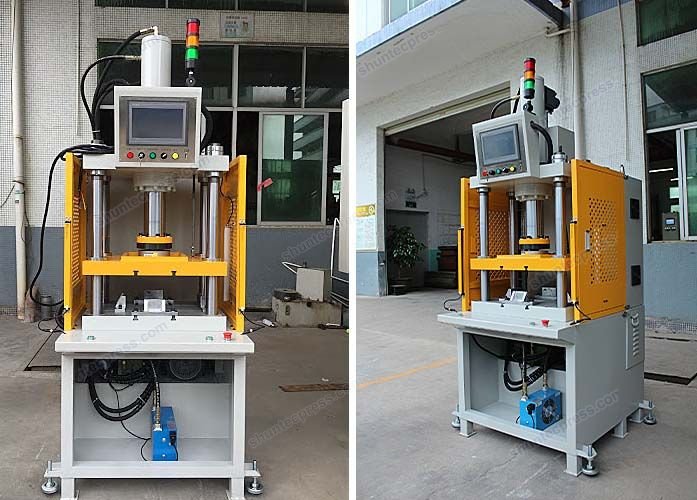
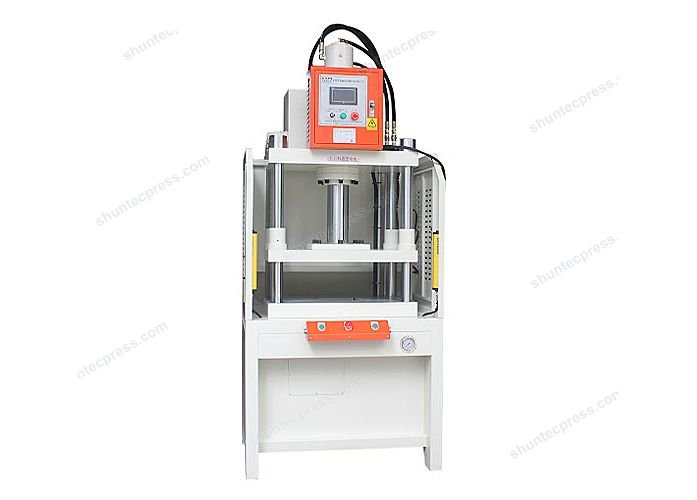
When The Servo-hydraulic Press Machine Is Working, If The Oil Temperature Rises Too Fast, It Will Cause A Series Of Adverse Effects For The Hydraulic System.
The temperature-rising and heating of the hydraulic system is a kind of comprehensive failure, just like pollution. It is mainly measured by testing the oil temperature and some hydraulic components. Temperature-rise will seriously affect the operation of the hydraulic system in the following ways.
1. It will increase the leakage of the servo-hydraulic press machine, and the volumetric efficiency of the pump and the whole system will be significantly reduced.
2. It will cause thermal deformation of the machine, which not only makes the gap between the moving parts with different thermal expansion coefficients in the hydraulic components become smaller and thus causes the parts to get jammed and causes malfunction, but affects the accuracy of the hydraulic equipment as well, resulting in poor parts processing quality.
3. It will also deform the rubber seals of the servo-hydraulic machine, causing premature aging and failure and reducing the service life.
It will not only invalidate the rubber seals but cause leakage as well, which will, in turn, cause further heat generation and temperature rise.
4. If the oil temperature of the servo-hydraulic press is too high, it will accelerate the process of oxidative deterioration of the oil, under which condition the pitch will be released, the service time of the hydraulic oil will be reduced.
5. As the oil temperature of the servo-hydraulic machine rises, the air separation pressure decreases, and the dissolved air escapes from the pump, resulting in cavitation, which lowers the working performance of the hydraulic system.

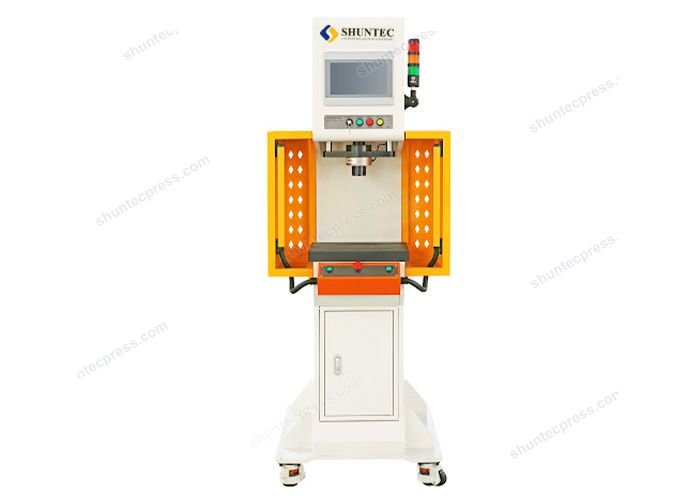
1. High Accuracy
Servo motor is used as a power source. The transmission mechanism is composed of a ball screw and a synchronous belt and is very simple and highly efficient. The repeat accuracy error is 0.01%.
2. Energy Saving
The energy released during the deceleration phase of the working cycle can be converted into electric energy for reuse, thereby reducing operating costs.
3. Precise Control
Electric servo press can realize precise control according to the set parameters. With the support of high-precision sensors, metering devices, and computer technology, it can greatly exceed the control accuracy that can be achieved by other control methods.
4. Improve The Level Of Environmental Protection
due to the reduction of the energy used and the optimized performance of the electric drive, the pollution sources are reduced and the noise is reduced, which provides a better guarantee for the environmental protection work of the factory.
5. Reduce Noise
The operating noise value of an electric servo press is less than 70 decibels and is about 2/3 of the noise value of a hydraulic press machine.
6. Cost Saving
electric servo press is exempt from the cost and trouble caused by the hydraulic control system because there is no hard pipe or hose required, and no need to cool the hydraulic oil.
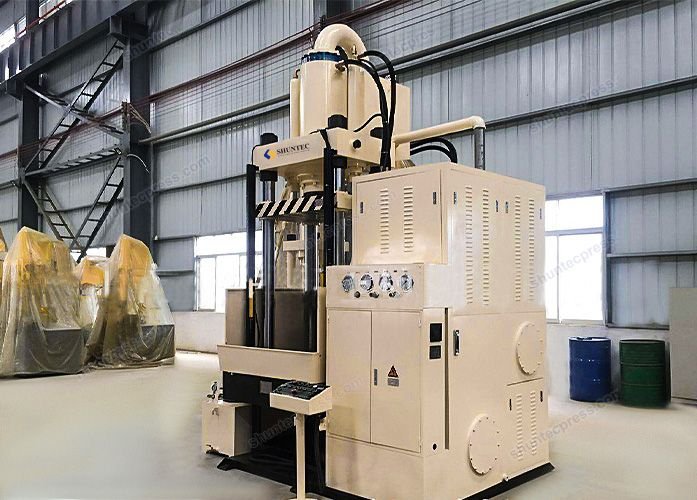

Hydroforming hydraulic press is a kind of metal forming press machine that uses fluid as the working medium to produce defined sizes and shapes. During the forming process, high-pressure fluid is used to generate pressure against the interior wall of the tube. Since the tube is sealed at both ends by a punch, and materials are supplemented to the tube, the pressure inside the tube is kept at a high level and forces the outer wall of the tube to completely match the mold cavity, and in this way, the intended shape is obtained.
Compared with traditional farming methods in which two-part halves are stamped and welded together, the hydroforming process can produce parts with high integrity, which means that the parts can be formed one time, and requires no or little subsequent welding procedures. It is also because there is no need for welding, the parts produced by hydroforming are of seamless bonding, which can achieve higher strength and better surfaces of the finished products. Besides, parts produced by hydroforming are lightweight. Compared with traditional metal stamped and welded parts, the weight of hydroformed parts can be reduced by 20% to 30%. Due to the one-time forming ability, work time and labor force can also be reduced significantly, which ultimately increases productivity.
Due to its various advantages, hydroforming hydraulic press has been used in the automotive industry, plumbing and heating industry, household appliance industry, aviation, and aerospace industry, etc.
Specifically, hydroforming technology is applied to water bulging hydraulic presses. This kind of press is highly capable of forming hollow complex-shaped components with integral structures.
Features Of Water Bulging Hydraulic Press
1, Working speed is fast and efficiency is high, whereas the energy consumption is low.
2, By virtue of sophisticated designs, the press can achieve high working pressure. Under high working pressure, the press can guarantee clear texture and thereby improve the appearance and quality of the finished products.
3, The press is equipped with a movable slide table, which makes it very convenient to load and unload materials. With this table, the height of the machine can be effectively reduced, and a high level of stability and reliability of the machine can be improved.
4, The press can realize the function of material withdrawal and material feeding, and improve the bulging limit of materials. Due to the bigger bulging limit, the press is especially suitable for the hydroforming of complex parts.
5, The hydraulic system is controlled by two-way cartridge valves, which can guarantee that the pressure loss is small and action is stable and reliable.
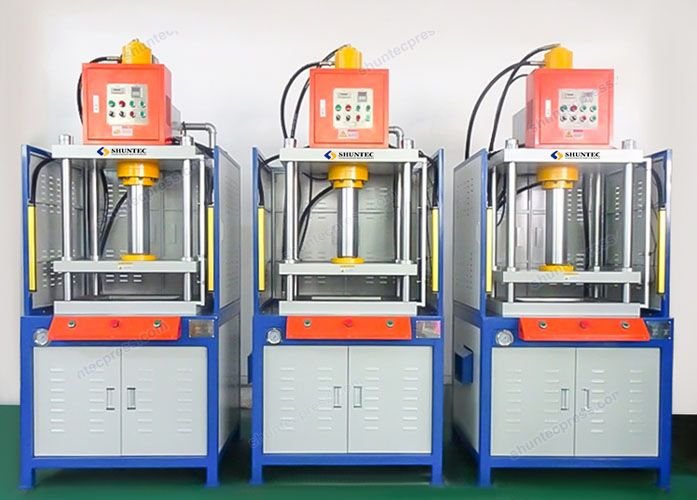

The four-column hydraulic press drives the operating mechanism by the motor through the transmission mechanism, applies pressure to the workpieces, and completes its processing process. The transmission mechanism is a reduction mechanism driven by a belt or gear. The transmission mechanism is a belt-drive or gear-drive decelerating mechanism; the operating mechanism is divided into a screw mechanism, a crank connecting rod mechanism, and a hydraulic cylinder. The transmission mechanism of a hydraulic press can not only complete various forms of complex motion and compound motion but also complete a large-scale continuous step-less speed regulation. Now let’s have a look at the issues that should be paid attention to when adjusting the pressure and reducing vibration of the press.
Pressure Adjustment Of four-Column Hydraulic Press
The pressure of debris cannot be higher than the pressure of the pump unless the hydraulic machine has a supercharging device. The actual pressure of the pump depends on the load size and is generated automatically rather than adjusted. The set pressure of a four-column hydraulic machine is the maximum pressure for normal operation. Lower the pressure of the overflow valve, adjust the overflow valve, and the pump outlet pressure will rise to the required value.
Vibration Reduction Methods Of Four-Column Hydraulic Press
After the four-column hydraulic press is used for a period of time, every time it starts or stops, there will be the vibration of the machine with noise. This is not good for the hydraulic press in the long run; it also affects the production efficiency and causes concern for the operator. Therefore, we
have to think of some methods to reduce the vibration.
The vibration caused by the alternating internal and external cycles of the hydraulic press process system, also known as forced vibration, is mainly caused by external interference. The vibration source must be eliminated first. Prevent the exciting force frequency of the four-column hydraulic press from approaching the natural frequency of the system to avoid resonance. the motor speed is changed or the spindle speed is changed to avoid resonance. Adopt the forward contact surface accuracy, reduce the roughness of the joint surface, eliminate the gap and the forward contact stiffness, which can eliminate vibration.
The Vibration Isolation Method Can Be Adopted To Reduce The Vibration Of The Four-Column Hydraulic Press
The motor and the bed can use flexible connections to isolate the vibration of the motor itself. the hydraulic buffer device can be used to reduce the shock when the components are reversed. thick rubber and wood can be used to isolate the machine from the foundation; consider using anti-vibration ditch separation equipment connected to the ground to prevent the surrounding vibration source from being transmitted to the hydraulic press through the ground.
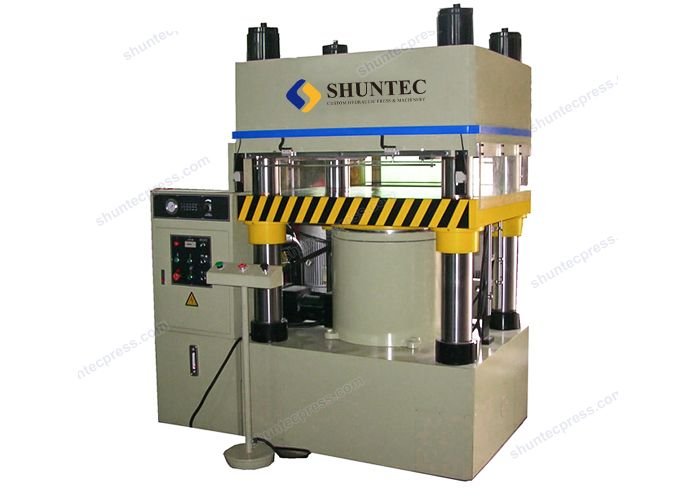
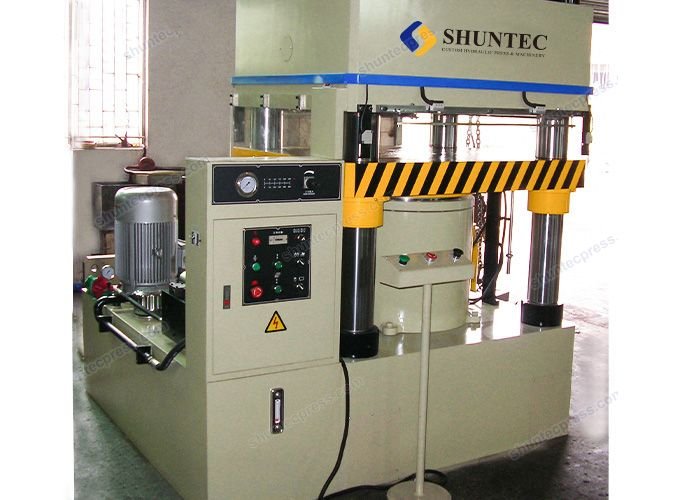
Die-cutting is the process in which a die is involved to shear or cut materials into the size and shape as determined by the die. Generally speaking, Applicable materials for the die-cutting process are low-strength materials, such as rubber, paper, paperboard, plastics, sheet metal, etc. The die-cutting press was first invented to address the issue of cutting leather for the shoe industry in the mid-19 century. In modern times, die-cutting has become a very typical post-processing procedure for printing materials.
In addition to printing materials, a die-cutting press machine is also often used for producing jigsaw puzzles. Jigsaw puzzles are produced by cutting pieces of wood or cardboard which are painted with a drawing into small pieces with intended sizes and shapes, and then people put these small pieces together to restore the original picture. Jigsaw puzzles inherently have higher requirements for the quality of cutting. Good-quality cutting should take out very little wood or cardboard so that the pieces can fit together well, otherwise, there will be too much gap between pieces. Besides, well-cut pieces should have a very smooth edge surface with minimum chipping.
In order to meet the above-mentioned requirements, a jigsaw puzzle dies cutting press machine has appeared accordingly. Jigsaw puzzle dies cutting press machine can be regarded as one of the most wonderful applications of the die-cutting process. This kind of machine can produce very intricate puzzle pieces with good quality and high precision. When combined with a hydraulic system and servo system, it can achieve even higher efficiency and productivity.
In real practice, a jigsaw puzzle cutting machine is usually combined with a jigsaw puzzle scattering machine and puzzle bagging machine to form a complete puzzle production line. Customers can decide whether to procure one machine or the whole production line according to actual needs.
Features Of Jigsaw Puzzle Die Cutting Press Machine:
1, The machine adopts a 4-post column structure which can achieve super rigidity and precision bed-to-ram parallelism and thus guarantee good cutting quality.
2, The machine can achieve fast approaching, pressing, and returning speed so that the productivity is high.
3, By virtue of its sophisticated designs and good quality materials used, the machine can not only achieve high work efficiency but needs little maintenance throughout the entire lifetime. This is very meaningful for manufacturers who are often annoyed by machine breakdowns from time to time.
4, The machine is equipped with a central color touch screen through which all parameters can be easily programmable.
5, The machine can achieve good quality cutting effect with a very smooth edge surface and minimum chipping. This can be the most noticeable feature that influences the manufacturer’s purchasing decision for the machine.
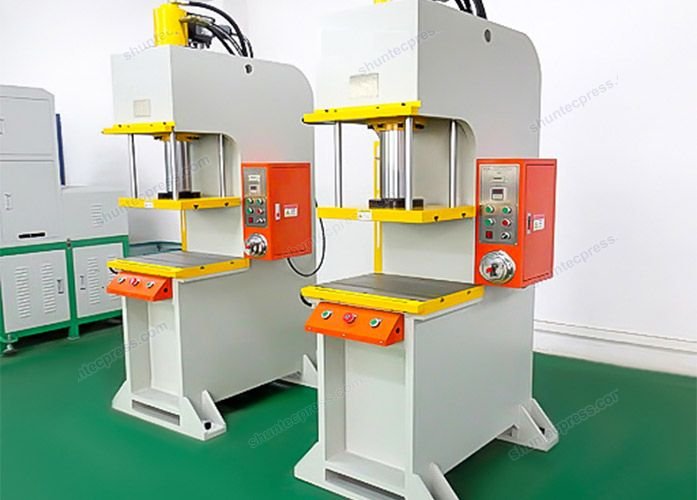

C frame hydraulic presses play different roles for different products. For shaft parts, profiles, etc., the C frame hydraulic press is mainly used to complete the pressing of the parts; for metal materials, it is mainly used for the stretching, blanking, bending, flanging, correction, pressing, and cold & hot extrusion of the material. It is also indispensable for compression molding of such products as powder products, plastic products, etc. How much do you know about the application and features of C frame presses? Let’s take a look!
Application Of C Frame Hydraulic Press
1. The C frame hydraulic press is mainly used for correction and press-fitting of shaft sleeve parts, and can also be used for other processing purposes.
2. As the C frame press stands upright, and its equipment parts are inside the machine body, the appearance is neat and beautiful.
3. The C frame hydraulic press can be used for handle and pedal operation. The pressure of the hydraulic press can be adjusted within the specified range. The stroke can be controlled with a relatively simple operation.
Three Features Of C Frame Hydraulic Press
1. The integral welded solid open structure of the press can keep the body rigid enough while having a convenient operating space.
2. The press has noticeable advantages such as good structural rigidity, good guiding performance, and fast speed, etc.
3. The convenient manual adjustment mechanism of the press can adjust the position of the pressure head or can press any position in stroke, and it can also arbitrarily adjust the distance of fast forward stroke and pressing stroke。
The C Frame Press Has Strong Versatility
It’s optional to have an additional pressure sensor to convert into a press-fitting force value and display it digitally through data acquisition and system processing composed of the PLC. When the force exceeds the limit, it will send out sound and light alarm and shutdown signal, so as to achieve automatic control of press-fitting force. The load display controller can control the value accurately and display it clearly; it has fast response speed and stable and reliable working conditions. Different sensors and application software can be replaced for different forging equipment with different tonnages. By using a counter, every operator knows the total number and the unqualified number. And the two-hand start button is added to make the operation of the machine safer.


For metal processing, in addition to routine processes such as heat treatment, press-fitting, compression, etc., there is another indispensable procedure that is called straightening. Straightening can eliminate or reduce deformation of the components, improve uniformity and create better geometry.
Importance Of Hydraulic Straightening Press
Nowadays, with higher and stricter requirements for components and end products in uniformity, geometry, accuracy, and cost-saving, hydraulic straightening presses have been more and more widely used by manufacturers who intend to improve productivity while saving costs. Hydraulic straightening presses are particularly useful for shafts, plates, and large weldments. Machining, heat treatment, and forming can cause these kinds of workpieces to warp or deform. Manufacturers have to remove or reduce such deformation before moving on to the next production steps. Especially for shafts, which are more complicated and have diversified sizes, it is barely possible to automate the straightening process, so a (hydraulic) straightening press is required.
Features Of Numerical Control Hydraulic Straightening Press
Even though an ordinary straightening press can also achieve the purpose of straightening, but it has a lot of unavoidable functional limitations. In order to increase the performance, an ordinary straightening press can be upgraded to include other functional systems or units, such as numerical control systems and hydraulic systems. A numerical control hydraulic straightening press has the following noticeable features:
1. Through the computer programming system, this press can accurately set the stroke of the indenter, effectively control the pressing distance, and avoid repeated straightening, which greatly improves the work efficiency and the straightening accuracy. The machine tool has an independent power mechanism, hydraulic and electrical systems, and its working pressure, pressure correction speed, and stroke range can be adjusted.
2. The stroke of the indenter can be numerically controlled and displayed, and the "0" point can be set arbitrarily.
3. Manual and automatic operation modes are available to choose from. Or the straightening distance can be controlled by the real-time display of the indenter stroke in the slow state.
4. The curvature of the workpiece straightened by the machine is not more than 0.02mm within the full length, and there is no crushing mark on the surface.
5. In the automatic state, the acceptance range of the shaft can be set. If the acceptance range is not reached, the indenter can be automatically straightened the workpiece until it reaches the said range.
Comparison Between Ordinary Straightening Machine And CNC Hydraulic Straightening Machine
1. Ordinary straightening press uses dial indicator to detect the accuracy, and it is not controllable, whereas the accuracy of CNC hydraulic straightening press is detected by the high-precision sensor and can reach 0.001mm.
2. The threshold for ordinary straightening machine operators is high with many years of work experience required. By comparison, CNC hydraulic straightening press can automatically complete the straightening of workpieces, and no working experience is required for the machine operators.
3. Working efficiency of the CNC hydraulic straightening machine is much higher than the ordinary straightening machine.
4. Ordinary straightening machines adopt manual quality inspection, and CNC hydraulic straightening machine adopts computer-automatic quality inspection.
5. Ordinary straightening machine controls the indenter manually, and it is difficult to control the accuracy by human experience. As for CNC hydraulic straightening machine, the pressing stroke is automatically calculated and controlled by a computer and the accuracy can reach 0.01mm.

